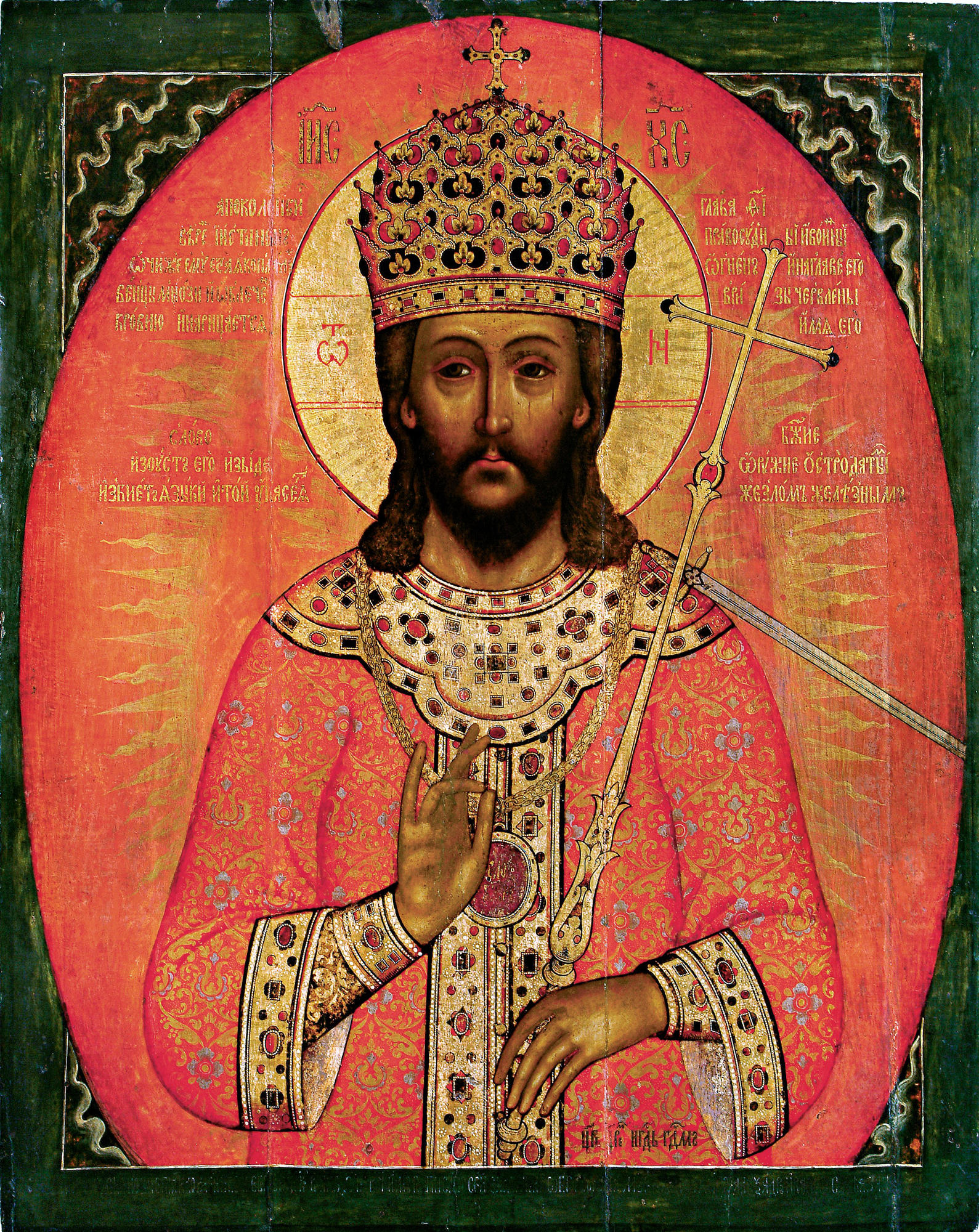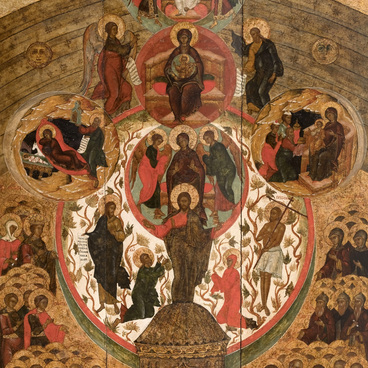The icon Jesus Christ, King of Kings was painted by Alexander Kazantsev in 1690. It was intended for the main church of Murom, the Cathedral of the Nativity of the Virgin. The icon author was born in 1658. He was born to a family of icon painters, who lived in a monastery settlement in Murom and made icons for the Monastery of the Annunciation. Alexander Kazantsev worked with his younger brother Fyodor, and, afterwards, with his son Pyotr. The artist’s great skill and original style suggest his studies in a workshop of the Armory Chamber in Moscow.
The icon depicts a bust-length portrait of Jesus Christ surrounded with a bright red halo with golden radiant rays inside. His clothes and accessories relate to the Apocalypse. Christ wears a crimson royal robe with a wide golden border. There is a high closed crown on his head. It resembles the “Cap of Kazan”– a precious regalia of Russian tsars.
Jesus Christ blesses worshipers with his right hand, while holding a sceptre topped with a cross in his left hand. A sword is coming out of his left shoulder. On the Christ”s chest there is an oval panagia (a kind of medallion) saying The Word of God.
In Byzantium, portraits of Christ wearing royal clothes and a crown were usually part of the Stabat Mater composition based on Psalm 44. At the same time, Christ”s royal robe was often combined with bishops” accessories like an omophorion and, more rarely, a saccos and a paterissa. In the late Middle Ages, the Savior’s royal garments were often associated with the Apocalypse (the title of a New Testament book) and the appearance of a rider on a white horse, who goes at the head of his army to battle with the beast and the kings of the earth.
Since the middle of the 16th century, the image of Christ, King of Kings, wearing a crown and sitting on a white horse with a sword coming out of his mouth was an obligatory part of the Russian cycles of apocalyptic illustrations. In the last quarter of the 17th century, a special type of Christ’s bust-length and throne images based on the Apocalypse was formed. He wears a tunic with long sleeves similar to the Russian tsars’ clothes, and a closed royal crown. The Savior holds a sceptre and his chest is decorated with a panagia saying The Word of God.
The most accurate analogy and prototype of the Murom Cathedral icon is the image of Christ, King of Kings, from the Veneration tier of the Archangel Cathedral of the Moscow Kremlin. This icon was painted on an ancient board by Armory Chamber masters in 1678-1680.
The icon depicts a bust-length portrait of Jesus Christ surrounded with a bright red halo with golden radiant rays inside. His clothes and accessories relate to the Apocalypse. Christ wears a crimson royal robe with a wide golden border. There is a high closed crown on his head. It resembles the “Cap of Kazan”– a precious regalia of Russian tsars.
Jesus Christ blesses worshipers with his right hand, while holding a sceptre topped with a cross in his left hand. A sword is coming out of his left shoulder. On the Christ”s chest there is an oval panagia (a kind of medallion) saying The Word of God.
In Byzantium, portraits of Christ wearing royal clothes and a crown were usually part of the Stabat Mater composition based on Psalm 44. At the same time, Christ”s royal robe was often combined with bishops” accessories like an omophorion and, more rarely, a saccos and a paterissa. In the late Middle Ages, the Savior’s royal garments were often associated with the Apocalypse (the title of a New Testament book) and the appearance of a rider on a white horse, who goes at the head of his army to battle with the beast and the kings of the earth.
Since the middle of the 16th century, the image of Christ, King of Kings, wearing a crown and sitting on a white horse with a sword coming out of his mouth was an obligatory part of the Russian cycles of apocalyptic illustrations. In the last quarter of the 17th century, a special type of Christ’s bust-length and throne images based on the Apocalypse was formed. He wears a tunic with long sleeves similar to the Russian tsars’ clothes, and a closed royal crown. The Savior holds a sceptre and his chest is decorated with a panagia saying The Word of God.
The most accurate analogy and prototype of the Murom Cathedral icon is the image of Christ, King of Kings, from the Veneration tier of the Archangel Cathedral of the Moscow Kremlin. This icon was painted on an ancient board by Armory Chamber masters in 1678-1680.




